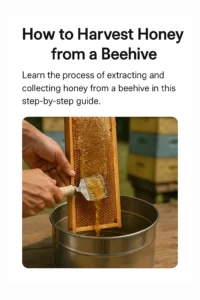The Beekeeper’s Calendar – Monthly Tasks for Healthy Hives
Introduction
Beekeeping is not a once-in-a-while task—it’s a year-round commitment. Every season brings different responsibilities and challenges for a beekeeper. Whether it’s preparing for spring buildup or managing winter survival, having a proper monthly plan ensures healthy colonies and maximum honey production. Here’s your complete Beekeeper’s Calendar for the year.

📆 Month-by-Month Beekeeping Tasks
🗓️ January – Monitor and Wait
- Check for adequate food stores.
- Avoid opening hives unless absolutely necessary.
- Protect from cold winds and moisture.
🗓️ February – Prepare for Spring
- On warmer days, quick hive inspections are okay.
- Feed sugar syrup if stores are low.
- Ready your equipment for the active season.
🗓️ March – Build-Up Begins
- Colonies start expanding.
- Add pollen substitutes and syrup if needed.
- Begin light inspections.
🗓️ April – Swarm Prevention
- Look for queen cells.
- Add extra boxes to give bees more room.
- Split colonies if they’re too strong.
🗓️ May – Full Bloom
- Main honey flow begins.
- Super your hives.
- Watch for swarms and re-queen if necessary.
🗓️ June – Peak Activity
- Monitor hive health regularly.
- Ensure adequate space for honey.
- Manage mites and pests.
🗓️ July – Honey Harvest
- Harvest ripe honey.
- Leave enough for the bees.
- Begin planning for fall.
🗓️ August – Begin Winter Prep
- Feed light hives.
- Combine weak colonies.
- Monitor for varroa and treat.
🗓️ September – Final Harvest
- Last round of honey collection.
- Ensure queen-right colonies.
- Add entrance reducers.
🗓️ October – Wintering Begins
- Finish feeding syrup.
- Install mouse guards.
- Add insulation if needed.
🗓️ November – Rest & Reflect
- Avoid disturbance to the hives.
- Evaluate the year’s performance.
- Repair and clean equipment.
🗓️ December – Quiet Time
- Let bees rest.
- Read, plan, and learn for next season.
Internal Link Suggestion
Want tools to help with these seasonal tasks?
👉 Explore Our Beekeeping Tools Collection
Conclusion
A successful beekeeper is a prepared beekeeper. Follow this calendar to ensure that your bees remain happy, healthy, and productive throughout the year. Keep buzzing with us for more in “The Beekeeper” blog series!
